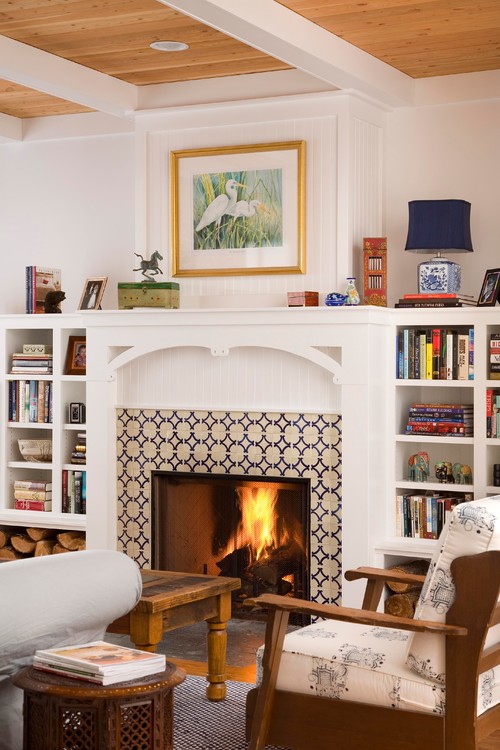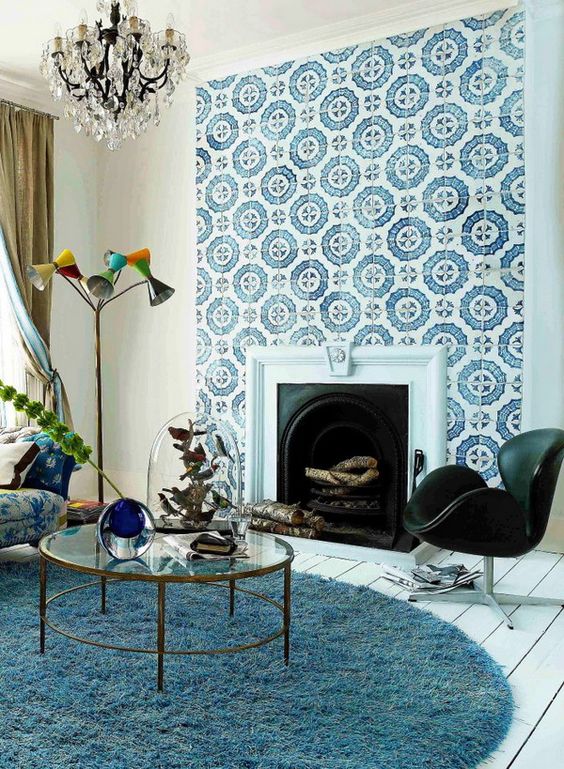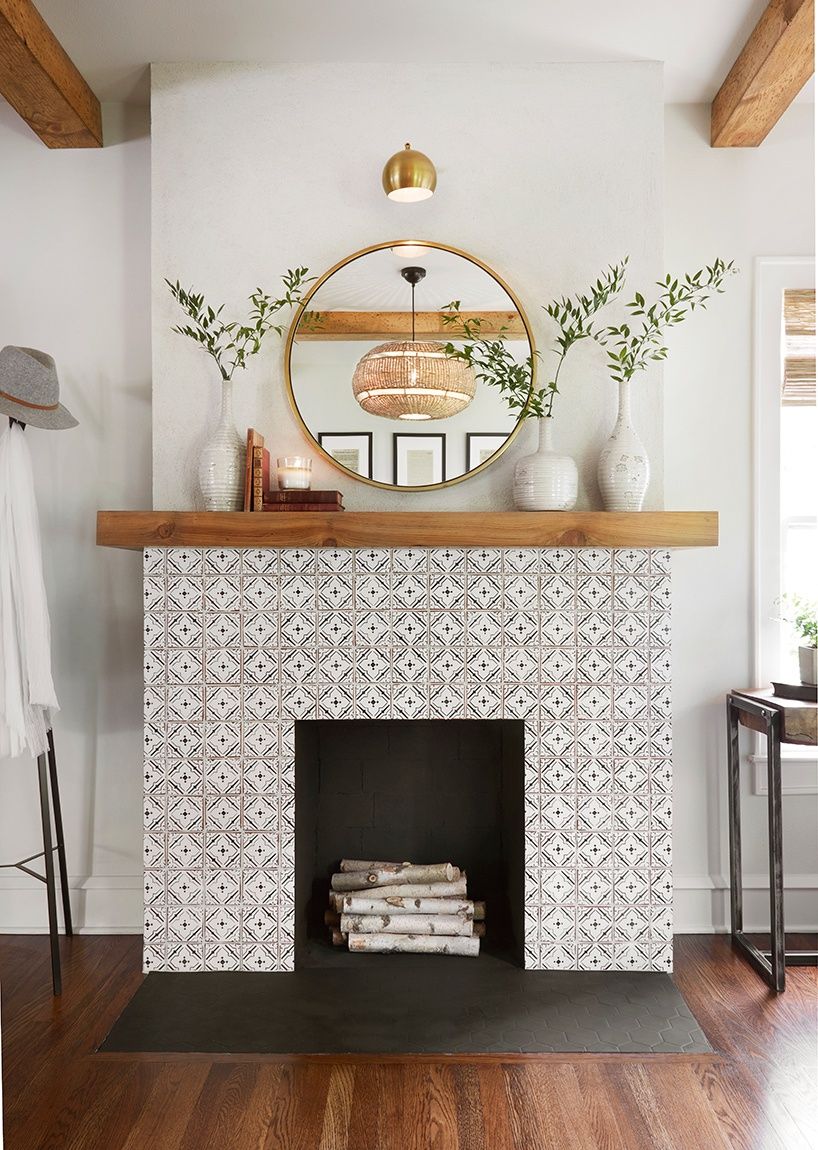Exploring the Charm of Retro Fireplace Tiles
There’s something undeniably captivating about the timeless appeal of retro fireplace tiles. Whether you’re renovating an old home or simply adding a nostalgic touch to a modern space, retro tiles offer a unique way to bring character and warmth to your fireplace. With a range of patterns, colors, and materials to choose from, these tiles can transform a standard fireplace into a stunning focal point that tells a story of a bygone era. Let’s dive into the world of retro fireplace tiles and explore how they can enhance your home.

Embracing the History: The Origins of Retro Fireplace Tiles
The allure of retro fireplace tiles lies not just in their visual appeal, but also in their rich history. These tiles date back to the late 19th and early 20th centuries, a time when tile-making was both an art and a craft. The Victorian era, in particular, saw a surge in the use of decorative tiles, with intricate patterns and vibrant colors becoming a staple in many homes. These tiles were often handcrafted, making each one a unique piece of art.
Retro tiles were typically made from materials like ceramic, porcelain, and sometimes even clay, each offering different textures and finishes. The designs often featured floral motifs, geometric patterns, and even scenes from nature, all of which were influenced by the artistic movements of the time, such as Art Nouveau and Arts and Crafts. The craftsmanship involved in creating these tiles meant that they were not just functional, but also a way to express one’s taste and social status.
Today, the resurgence of interest in retro tiles can be attributed to a growing appreciation for the craftsmanship and aesthetic qualities of these historical pieces. Whether you’re a history buff or simply someone who appreciates the charm of vintage decor, incorporating retro fireplace tiles into your home is a way to connect with the past while creating a warm and inviting atmosphere.

Choosing the Perfect Retro Tile Pattern for Your Fireplace
Selecting the right pattern for your retro fireplace tiles is key to achieving the desired look. Retro tiles come in a wide array of designs, each evoking a different era and style. When choosing a pattern, consider the overall theme of your home and the statement you want your fireplace to make.
For a Victorian-inspired look, consider tiles with intricate floral patterns or damask designs. These tiles often feature deep, rich colors like burgundy, navy, and forest green, which can create a luxurious and cozy atmosphere. If your home has a more Arts and Crafts influence, look for tiles with simpler, nature-inspired motifs like leaves, vines, or animals, often rendered in earthy tones like brown, ochre, and olive.
Geometric patterns are another popular choice, particularly if you’re aiming for an Art Deco or mid-century modern vibe. These tiles often feature bold shapes like diamonds, hexagons, or chevrons, and are typically done in contrasting colors like black and white or gold and navy. The repetition of shapes can create a sense of order and symmetry, making your fireplace the focal point of the room.
The color palette of your tiles is also crucial. Bright, bold colors can make a statement, while softer, muted tones can create a more subdued and elegant look. Consider how the colors of the tiles will complement or contrast with the surrounding decor, including your walls, furniture, and flooring.
Ultimately, the pattern you choose should reflect your style and the ambiance you want to create in your space. Whether you’re going for a bold, dramatic look or something more subtle and refined, the right pattern can bring your vision to life.

The Best Materials for Retro Fireplace Tiles
When it comes to retro fireplace tiles, the material you choose can greatly impact both the appearance and functionality of your fireplace. Traditional materials like ceramic, porcelain, and clay have stood the test of time, offering durability and a range of finishes that can enhance the retro aesthetic.
Ceramic tiles are a popular choice for their versatility and affordability. They can be glazed to achieve a shiny, polished look or left unglazed for a more rustic, matte finish. The glaze not only adds to the aesthetic appeal but also makes the tiles more resistant to heat and stains, making them ideal for a fireplace surround.
Porcelain tiles are another excellent option, particularly if you’re looking for something more durable. Porcelain is a type of ceramic that is fired at a higher temperature, making it denser and less porous. This makes porcelain tiles more resistant to moisture and wear, which is particularly important if your fireplace is in a high-traffic area. Porcelain tiles can also be glazed or unglazed and come in a variety of finishes, including matte, glossy, and even textured.
For a truly authentic retro look, consider using clay tiles. Clay was one of the original materials used for tile-making and offers a warm, earthy quality that is hard to replicate. Clay tiles are often handmade, which means each tile can have slight variations in color and texture, adding to the overall charm. However, clay tiles are more porous than ceramic or porcelain, so they may require more maintenance to keep them looking their best.
Glass tiles are another material to consider if you’re looking to add a touch of glamour to your fireplace. Glass tiles were popular in the Art Deco period and can create a stunning visual effect when used in a fireplace surround. They reflect light beautifully, making the fireplace a focal point even when it’s not in use. However, glass tiles can be more expensive and require careful installation to avoid chipping.
Each material offers its own unique set of benefits and drawbacks, so it’s important to consider your specific needs and the overall look you want to achieve when selecting your retro fireplace tiles.

Installation Tips for Retro Fireplace Tiles
Installing retro fireplace tiles can be a rewarding project, but it does require careful planning and execution to ensure a professional-looking result. Whether you’re a seasoned DIYer or a beginner, following some key tips can help you achieve the perfect retro fireplace.
The first step is to prepare the surface of your fireplace. This involves cleaning the existing surface to remove any dirt, grease, or loose material that could affect the adhesion of the tiles. If your fireplace has an existing tile or brick surround, you’ll need to ensure it is smooth and level before installing the new tiles. Any imperfections in the surface can cause the tiles to sit unevenly, leading to a less-than-perfect finish.
Next, plan your tile layout before you start adhering anything to the fireplace. This step is crucial to avoid any mistakes that could be difficult to fix later on. Start by measuring the area and then lay out the tiles on the floor to get a sense of how they will look once installed. This is also the time to make any necessary cuts to the tiles. Using a tile cutter or wet saw, carefully trim the tiles to fit around corners, edges, or any obstacles like mantels or hearths.
When it comes to adhering to the tiles, using the right type of adhesive is essential. For a fireplace, you’ll need a heat-resistant tile adhesive that can withstand the high temperatures your fireplace will generate. Apply the adhesive to the back of each tile using a notched trowel, then press the tile firmly onto the surface. Be sure to check that each tile is level as you go, using tile spacers to ensure consistent spacing between tiles.
After the tiles are in place and the adhesive has cured, the next step is grouting. Choose a grout color that complements your tile pattern and apply it using a grout float, making sure to fill all the gaps between the tiles. Wipe away any excess grout with a damp sponge before it dries. Once the grout has been set, seal the grout lines with a grout sealer to protect against stains and moisture.
Finally, step back and admire your work. Installing retro fireplace tiles is not just about the technical aspects; it’s about creating a space that reflects your style and adds warmth and character to your home.

How to Maintain and Clean Retro Fireplace Tiles
Once your retro fireplace tiles are installed, proper maintenance and cleaning are key to keeping them looking their best for years to come. Different materials require different levels of care, so it’s important to understand the needs of your specific tiles.
For ceramic and porcelain tiles, regular cleaning is relatively straightforward. Use a soft cloth or sponge with warm water and a mild detergent to wipe down the tiles. Avoid using abrasive cleaners or scouring pads, as these can scratch the surface of the tiles. For more stubborn stains, a mixture of baking soda and water can be used to gently scrub the area. Be sure to rinse the tiles thoroughly to remove any residue.
Clay tiles require a bit more care due to their porous nature. It’s important to seal clay tiles regularly to protect them from moisture and stains. Use a penetrating sealer that is designed for porous surfaces, and reapply it every few years or as needed. When cleaning clay tiles, use a soft brush and a mild cleaner, and avoid letting water sit on the tiles for too long, as this can lead to staining or discoloration.
If you have glass tiles in your fireplace surround, keeping them clean is essential to maintaining their reflective quality. Use a glass cleaner and a soft cloth to wipe down the tiles, being careful not to leave streaks. For an extra shine, you can buff the tiles with a dry microfiber cloth after cleaning. Glass tiles are also prone to scratching, so be sure to handle them with care.
Grout maintenance is another important aspect of caring for your retro fireplace tiles. Over time, grout lines can become discolored or cracked, especially in areas exposed to high heat. To keep the grout looking fresh, clean it regularly with a grout cleaner or a mixture of baking soda and water. If the grout starts to show signs of wear, you may need to regrout the tiles to restore their appearance.
Finally, be mindful of the overall environment around your fireplace. If you burn wood or other fuels, soot and ash can accumulate on the tiles, so be sure to clean them regularly. Using a fireplace screen can help reduce the amount of debris that settles on your tiles, making maintenance easier.

Incorporating Retro Fireplace Tiles into Modern Decor
One of the most exciting aspects of retro fireplace tiles is their ability to blend seamlessly with modern decor. While these tiles evoke a sense of history, they can also be paired with contemporary design elements to create a stylish and unique look.
One way to integrate retro tiles into a modern space is by using them as an accent rather than the main feature. For example, you can choose retro tiles for the fireplace surround while keeping the rest of the room’s decor minimalist and neutral. This contrast allows the tiles to stand out without overwhelming the space.
Another approach is to mix and match retro tiles with modern materials. Pairing retro tiles with sleek, contemporary finishes like stainless steel or glass can create a striking juxtaposition that highlights the charm of the retro design while maintaining a modern aesthetic. For instance, a retro tile fireplace can be complemented with a modern metal mantel or contemporary furnishings.
When it comes to color, don’t be afraid to use bold or unexpected combinations. Retro tiles often come in vibrant colors and patterns, but you can balance them with neutral tones and modern accents to keep the overall look cohesive. For example, a fireplace with bold retro tiles can be paired with neutral walls and modern furniture to create a balanced and stylish space.
Lighting also plays a crucial role in showcasing retro tiles. Consider installing adjustable lighting or spotlights to highlight the intricate patterns and textures of your tiles. Proper lighting can enhance the visual impact of the tiles and make them a focal point of the room.
Finally, remember that retro tiles don’t have to be confined to traditional spaces. They can be incorporated into a variety of design styles, from eclectic and bohemian to industrial and modern. The key is to find a balance that allows the retro tiles to shine while complementing the overall decor of your space.

Common Mistakes to Avoid
When working with retro fireplace tiles, several common mistakes can detract from the final result. Avoiding these pitfalls will help ensure a successful and satisfying installation.
One common mistake is not properly preparing the surface before installation. It’s essential to ensure that the surface is clean, dry, and level before applying adhesive. Any imperfections in the surface can lead to uneven tile placement and a less polished appearance.
Another mistake is failing to plan the tile layout. Without a clear layout plan, you might end up with awkward cuts or mismatched patterns. Spend time arranging the tiles on the floor and making any necessary adjustments before starting the installation to avoid these issues.
Choosing the wrong adhesive or grout for your tiles can also be problematic. For example, using a standard adhesive instead of a heat-resistant one can result in tiles coming loose over time. Similarly, using the wrong type of grout can lead to discoloration or deterioration. Make sure to use products that are specifically designed for fireplace applications.
Improper tile cutting is another common issue. Cutting tiles incorrectly can result in uneven edges and gaps. Use a tile cutter or wet saw for clean, precise cuts, and measure carefully to ensure a proper fit. If you’re unsure about cutting tiles yourself, consider seeking professional help.
Overlooking maintenance is another mistake that can affect the longevity of your tiles. Regular cleaning and sealing are important to keep your retro tiles looking their best. Neglecting these tasks can lead to staining, discoloration, or damage.
Lastly, don’t forget to consider the overall design of the room. Retro tiles can make a bold statement, but they should complement the rest of the decor rather than clash with it. Take into account the color scheme, furniture, and other design elements to ensure a cohesive look.

What are retro fireplace tiles made of?
Retro fireplace tiles are typically made from materials like ceramic, porcelain, clay, and glass. Each material offers unique benefits and aesthetic qualities. Ceramic and porcelain tiles are durable and come in a range of finishes and patterns, while clay tiles provide a more rustic, handcrafted look. Glass tiles add a touch of glamour and reflect light beautifully. The choice of material depends on the desired look and functional needs of your fireplace.
How do I choose the right pattern for my retro fireplace tiles?
Choosing the right pattern involves considering the overall style of your home and the look you want to achieve. For a Victorian or Arts and Crafts style, opt for intricate floral or nature-inspired motifs. If you prefer an Art Deco or mid-century modern vibe, geometric patterns in bold colors are a great choice. Consider how the pattern will complement other design elements in the room and how it fits with your style.
Can I install retro fireplace tiles myself?
Yes, installing retro fireplace tiles can be a DIY project if you have some basic skills and tools. Key steps include preparing the surface, planning the tile layout, applying adhesive, and grouting. However, if you’re not confident in your tiling skills or if your fireplace has complex features, it might be worth hiring a professional to ensure a high-quality installation.
How do I maintain and clean retro fireplace tiles?
Maintenance depends on the type of tile material. Ceramic and porcelain tiles can be cleaned with mild detergent and water, while clay tiles should be sealed regularly to protect against moisture and stains. Glass tiles can be cleaned with a glass cleaner and a soft cloth. Regular cleaning and sealing of grout lines are also important to keep the tiles looking their best.
Can retro fireplace tiles be used with modern decor?
Absolutely. Retro fireplace tiles can be seamlessly integrated into modern decor by using them as an accent or pairing them with contemporary materials. Balancing bold retro patterns with neutral tones and modern furnishings can create a stylish and cohesive look. Lighting can also enhance the impact of the retro tiles while maintaining a modern aesthetic.
Are retro fireplace tiles heat-resistant?
Yes, most retro fireplace tiles are designed to withstand the high temperatures associated with fireplaces. Ceramic and porcelain tiles, in particular, are heat-resistant and suitable for use in fireplace surrounds. If you’re using clay or glass tiles, ensure they are rated for high heat to avoid any issues. Always follow the manufacturer’s guidelines for installation and maintenance to ensure the tiles perform well in your fireplace setting.

Related Posts: